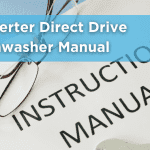Table of Contents
A microwave that won’t heat is as useful as a chocolate teapot in kitchen appliances. Finding yourself in a pickle with a Whirlpool Microwave Not Heating can be disconcerting, especially if it’s the Model #WMH53521H. This champion appliance scooped the top spot in the 2020 Consumer Reports Buying Guide with an impressive overall score of 83. But don’t fret. This situation isn’t beyond redemption, and your trusty Whirlpool microwave oven can be brought back to its full heating glory.
| Troubleshooting Step | Symptoms | Tools Required | Warnings |
|---|---|---|---|
| Discharge Capacitor | Microwave is unplugged, but still potentially dangerous due to retained electrical charge | Nitrile gloves, Insulated Needle Nose Pliers or Insulated Screwdrivers | High electrical shock risk |
| Test Diode | Microwave not heating; the diode may be burned out | Multimeter, 9-Volt battery | None |
| Test Door Switches | Microwave not starting or heating; door switches may be defective | Multimeter | None |
| Test Magnetron | Microwave not heating; the magnetron might be defective | Multimeter | High electrical shock risk |
| Test High-Voltage Capacitor | Microwave not heating; the capacitor might be defective | Multimeter | High electrical shock risk |
| Test High-Voltage Transformer | Microwave not heating, potential burning smell; the transformer might be defective | None (smell test) | High electrical shock risk |
| Test for Overheating | Microwave shuts off; there may be a blown thermal fuse, a blown cavity fuse, or a defective thermoprotector | Multimeter | High electrical shock risk |
| Check Control Board | All previous possibilities exhausted; the control board might be defective | None (visual inspection for burn marks or cracks) | None |
Before we dive in, here’s a heads-up on the tools you’ll need:
- Multimeter (to decode the language of electrical current)
- 9-Volt battery
- Insulated Needle Nose Pliers and Screwdrivers
- Nitrile gloves
Safety Alert
Take this caution as seriously as you would a bull in a china shop: a microwave oven can discharge potent electric jolts that could lead to injury or worse. Unplug the microwave from its wall socket before you start.
Remember, like an elephant, the microwave’s capacitor never forgets – it retains an electrical charge even when unplugged. So, discharge the capacitor before proceeding.
How To Discharge the Capacitor
- With gloves on, access the capacitor and disconnect the two terminals.
- Touch each terminal with the metal part of your needle-nose pliers.
- If using two screwdrivers, make them touch each terminal and then each other.
Expect a spark or a zapping sound – the sound of success.
The Diode: Small But Mighty
In the world of microwave mechanics, the diode is the unsung hero. It works with the capacitor to convert AC power to DC, effectively doubling the voltage to an impressive 5,000 volts. This voltage is then sent to the magnetron, which sends microwaves into the inner cavity to heat your food. If the diode is burned out, it’s like losing a key player in the middle of a game.
How to Test the Diode
A continuity test will help you crack the case. If the diode has continuity in both directions or tests negative, then it’s a goner.
Door Switches: The Safety Watchdogs
A microwave oven is equipped with a minimum of 3 door switches. They’re the watchdogs, ensuring the microwave can’t operate with the door open. If any of them go rogue, the oven will refuse to heat.
Test each switch with your multimeter. Any switch that tests negative is the black sheep and needs replacement.
The Magnetron: The Microwave’s Beating Heart
When the transformer, diode, and capacitor harmoniously convert AC to DC, the magnetron steps up, sending microwaves into the inner cavity to heat your food. If the multimeter reading exceeds 1 ohm, your magnetron is fine.
If not, the only option is a replacement. But, like buying a diamond, it is costly. Weigh the pros and cons before you decide.
Capacitor & Transformer: The Power Couple
Paired with the diode, the capacitor converts AC current to DC and doubles the voltage. If it’s malfunctioning, it’s like a gear in the machine gone missing, and the microwave will refuse to heat.
Like a red flag, a burning smell is the unmistakable sign of a failing transformer. In this case, replace it post-haste.
Control Board: The Mastermind
The control board, the brains of the operation, is our last suspect. Examine it for burn marks or cracks. If you spot any, then you’ve hit the bullseye. Replace it and celebrate your successful detective work.
However, consider calling a professional if DIY troubleshooting seems hard to crack. Sometimes, leaving it to the experts is the best card to play.
Frequently Asked Questions
Q: Why does my microwave turn off by itself?
A: This might be a sign that the high-voltage transformer is defective. Other culprits could be a blown thermal fuse, a blown cavity fuse, or a defective thermoprotector. If the microwave didn’t shut off, it could overload and start a fire.
Q: How can I tell if the diode is damaged or burned out?
A: A simple continuity test can help you find out. If the diode tests negative one way or the other or has continuity in both directions when the leads are reversed, it’s damaged.
Q: What does it mean if I smell something burning when the microwave is in operation?
A: This might mean your high-voltage transformer is failing. Turn off and unplug the microwave immediately, and consider getting a new transformer.
Q: Can the magnetron be repaired?
A: Unfortunately, no. If the magnetron is faulty, it needs to be replaced. This is a costly repair, and you should consider whether replacing the entire microwave is more cost-effective.




